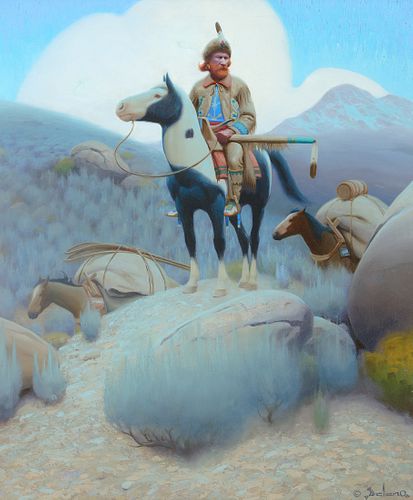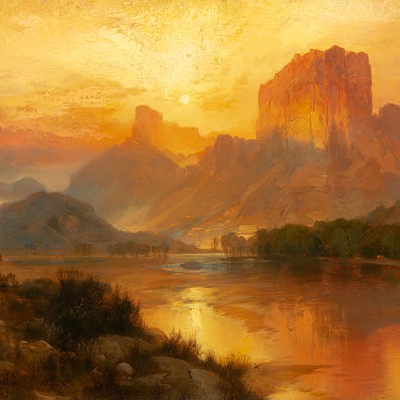Gerard Curtis Delano (1890-1972); The Mountain Man
Lot 88
About Seller
Coeur d'Alene Art Auction
11944 North Tracey Road
Hayden, ID 83835
United States
Coeur d’Alene Art Auction specializes in the finest classical Western and American Art representing past masters and outstanding contemporary artists. The auction principals have over 100 years of combined experience in selling fine art and have netted their clients over $325 million in the last fif...Read more
Estimate:
$250,000 - $350,000
Absentee vs Live bid
Two ways to bid:
- Leave a max absentee bid and the platform will bid on your behalf up to your maximum bid during the live auction.
- Bid live during the auction and your bids will be submitted real-time to the auctioneer.
Bid Increments
| Price | Bid Increment |
|---|---|
| $0 | $250 |
| $5,000 | $500 |
| $10,000 | $1,000 |
| $20,000 | $2,500 |
| $50,000 | $5,000 |
| $100,000 | $10,000 |
| $200,000 | $25,000 |
| $500,000 | $50,000 |
| $1,000,000 | $100,000 |
About Auction
By Coeur d'Alene Art Auction
Jul 25, 2020
Set Reminder
2020-07-25 15:00:00
2020-07-25 15:00:00
America/New_York
Bidsquare
Bidsquare : Fine Western & American Art
https://www.bidsquare.com/auctions/coeur-dalene/fine-western-american-art-5263
The 2020 Coeur d'Alene Art Auction to be held July 25 in Reno, Nevada, will feature 264 selections of unparalleled quality in Western paintings and sculpture from historical and contemporary artists such as Charles M. Russell, Henry Farny, Thomas Moran, Edward S. Curtis, Carl Rungius, and more. Coeur d'Alene Art Auction info@cdaartauction.com
The 2020 Coeur d'Alene Art Auction to be held July 25 in Reno, Nevada, will feature 264 selections of unparalleled quality in Western paintings and sculpture from historical and contemporary artists such as Charles M. Russell, Henry Farny, Thomas Moran, Edward S. Curtis, Carl Rungius, and more. Coeur d'Alene Art Auction info@cdaartauction.com
- Lot Description
Gerard Curtis Delano (1890-1972)
The Mountain Man
oil on canvas
36 x 30 inches
signed lower right
VERSO
Signed and titled
The fur trade was an important part of the exploration east of the Mississippi, but by 1810 it became the domain of the mountain man as the country moved West. Mountain men numbered approximately 3000 between the early 1800’s through their peak in the 1840’s, and while many were free trappers, the majority worked for the preeminent fur companies of the day. They were company men, living a life that was almost military in nature. They trapped and hunted in brigades, ate in mess groups, and reported to a “boosway”, or leader of their respective trapping party.
Trails were cut and opened up by these mountain men for mule train- based inland fur trade, and many of these routes were later widened into wagon roads which enabled Americans to travel from the east to settle the new territories of the west by wagon trains.
International treaties in 1846 and 1848 spurred a large upsurge in migration with the official settlement of new western coastal territories in the United States, while at the same time overlapping in the fur industry made it less possible for mountain men to make a good living. The lure of cheap land in the west spurned a wave of emigrants westward which persisted into the late 1880s. As the beaver-based fur trade and silk trade shrank, many mountain men became wagon train guides, Army Scouts and settlers, canvasing the same lands they had been instrumental in opening up.
PROVENANCE
Gloria Gray, Riverside, CA
Private Collection, AZSurface condition is very good. Several small hairline cracks to left of trapper’s head and to left of horse’s head. No signs of inpainting.Condition
- Buyer's Premium



 EUR
EUR CAD
CAD AUD
AUD GBP
GBP MXN
MXN HKD
HKD CNY
CNY MYR
MYR SEK
SEK SGD
SGD CHF
CHF THB
THB












